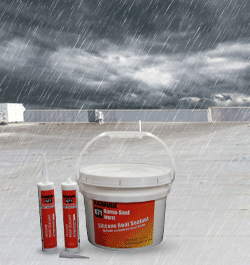UP TO THE MINUTE
How fluid-applied roofing systems are advancing performance and reliability
November 16, 2025 at 3:00 a.m.CCS Influencer John Kenney says that the contractors who use fluid-applied systems wisely will lead in reliability, performance and client confidence.
In the fluid-applied roofing world, the past year has seen some meaningful advances, not just flashy marketing hype but tools and formulations that add real value on the jobsite. Companies that stay aware of these developments can offer stronger systems, reduce risk and win more work by showing clients they know the latest. Here’s what I’m seeing that’s worth your attention.
One of the most significant shifts is toward enhanced polymer chemistry. Fluids with improved elastomeric bases, whether advanced silicones, polyurethanes or hybrid-modified systems, provide better adhesion, elongation and recovery. That means the coating holds tight during temperature swings, resists ponding stress more effectively and better accommodates structural movement. For roofs with lots of thermal expansion and contraction, that’s a significant step up in durability.
Closely tied to that are low-odor, low-VOC formulations. Contractors and building owners have rejected the days of pungent fumes and long curing times. New fluid-applied membranes that cure faster and emit fewer volatile compounds allow work in more sensitive environments, such as schools, hospitals and occupied commercial spaces, without extensive ventilation or disruption. When you can offer that, you’re not just selling waterproofing; you’re selling convenience and flexibility.
A third development is reinforced fabric integration and hybrid systems. Rather than relying solely on the fluid layer, many systems now embed high-tensile fabrics or scrims into the coating. That hybrid structure helps control cracks and bridge joints and increases puncture resistance. If a building has joint movement, overlaying surfaces or substrate irregularities, those reinforcements can distinguish between a patch job and a long-term solution.
Alongside, there’s been growth in innovative, color-shifting or solar-reflective coatings designed to respond to sunlight and temperature. Some newer fluids include thermochromic or reflective pigments that reduce heat absorption, giving the roof a cooler surface under intense sun. That helps reduce heat stress on insulation and the envelope, especially in hot climates or exposed rooftop systems. For owners watching energy bills, that’s not a small benefit but a selling point.
Another area gaining traction is self-healing or microcapsule-based coatings. These are still emerging, but systems that contain tiny capsules filled with sealing agents activated when the membrane is punctured offer passive protection. A small nail-through or micro-crack can trigger local repair without a complete coating reapplication. It’s not yet widespread, but contractors experimenting with these systems are seeing promise in long-term risk reduction.
Equally important has been the improvement in moisture-tolerant or damp-substrate primers and base layers. In many retrofit or recoat projects, moisture in decks or substrate dampness is a constant challenge. New primer formulas can tolerate a higher threshold of residual moisture, improving adhesion without waiting for the surface to dry completely. That buys you schedule flexibility and reduces delays caused by weather or substrate conditions.
One last development to watch is monitoring and smart sensor integration in fluid systems. Some newer membranes are engineered to work with embedded sensors or conductive layers that detect leaks or failures before they become full-blown water intrusion problems. It’s still nascent, but combining fluid-applied systems with envelope monitoring gives contractors something valuable to offer: earlier warnings, faster responses and extended warranty confidence.
If you adopt these advances selectively and back them with proper training, you won’t be chasing novelty. You’ll expand your offering with better tools you already understand: coatings, adhesion, detailing and project management. The contractors who use fluid-applied systems wisely, integrating new chemistry, reinforcement and monitoring, will not just compete — they’ll lead in reliability, performance and client confidence.
John Kenney is the CEO of Cotney Consulting Group. See his full bio here.



















Comments
Leave a Reply
Have an account? Login to leave a comment!
Sign In